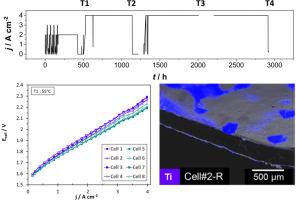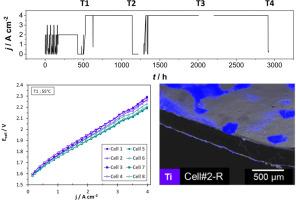Degradation mechanisms of a proton exchange membrane water electrolyzer stack operating at high current densities
IF 5.6
3区 材料科学
Q1 ELECTROCHEMISTRY
引用次数: 0
Abstract
On the path to an emission free energy economy, proton exchange membrane water electrolysis (PEMWE) is a promising technology for a sustainable production of green hydrogen at high current densities and thus high production rates. Long lifetime, increasing the current density and the reduction of platinum group metal loadings are major challenges for a widespread implementation of PEMWE. In this context, this work investigates the aging of a PEMWE stack operating at 4 A cm-2, which is twice the nominal current density of commercial electrolyzers. Specifically, an 8-cells PEMWE stack using catalyst coated membranes (CCMs) with different platinum group metal (PGM) loading was operated for 2200 h. To understand degradation phenomena, physical ex-situ analyses, such as scanning electron microscopy (SEM), atomic force microscopy (AFM) and X-ray photoelectron spectroscopy (XPS), were carried out. The same aging mechanism were observed in all cells, independent on their position in stack or the specific PGM loading of the membrane electrode assembly (CCM): (i) a decrease of ohmic resistance over time related to membrane thinning, (ii) a significant loss of ionomer at anodes, (iii) loss of noble metal from the electrodes leading to deposition of small Ir and Pt concentrations in the membrane, (iv) heterogeneous enrichment of Ti on the cathode side likely originating from the cathode-side of the Ti bipolar plates (BPPs). These results are in good agreement with the electrochemical performance loss. Thus, we were able to identify the degradation phenomena that dominate under high-current operation and their impact on performance.


高电流密度下质子交换膜水电解槽堆的降解机理
在通往无排放能源经济的道路上,质子交换膜水电解(PEMWE)是一种有前途的技术,可以在高电流密度和高生产率下可持续生产绿色氢。长寿命、增加电流密度和减少铂族金属负载是广泛实施PEMWE的主要挑战。在这种情况下,这项工作研究了在4 a cm-2下工作的PEMWE堆的老化,这是商业电解槽额定电流密度的两倍。具体来说,使用不同铂族金属(PGM)负载的催化剂涂层膜(CCMs)的8个电池PEMWE堆栈运行了2200小时。为了了解降解现象,进行了物理非原位分析,如扫描电子显微镜(SEM),原子力显微镜(AFM)和x射线光电子能谱(XPS)。在所有细胞中观察到相同的老化机制,与它们在堆叠中的位置或膜电极组件(CCM)的特定PGM负载无关。(1)随着时间的推移,与膜变薄有关的欧姆电阻降低;(2)阳极上离子的显著损失;(3)电极上的贵金属损失导致膜上沉积少量的Ir和Pt浓度;(4)阴极上的Ti不均匀富集可能源于Ti双极板(BPPs)的阴极侧。这些结果与电化学性能损失基本一致。因此,我们能够识别在大电流操作下占主导地位的退化现象及其对性能的影响。
本文章由计算机程序翻译,如有差异,请以英文原文为准。
求助全文
约1分钟内获得全文
求助全文
来源期刊

Electrochimica Acta
工程技术-电化学
CiteScore
11.30
自引率
6.10%
发文量
1634
审稿时长
41 days
期刊介绍:
Electrochimica Acta is an international journal. It is intended for the publication of both original work and reviews in the field of electrochemistry. Electrochemistry should be interpreted to mean any of the research fields covered by the Divisions of the International Society of Electrochemistry listed below, as well as emerging scientific domains covered by ISE New Topics Committee.
 求助内容:
求助内容: 应助结果提醒方式:
应助结果提醒方式:


